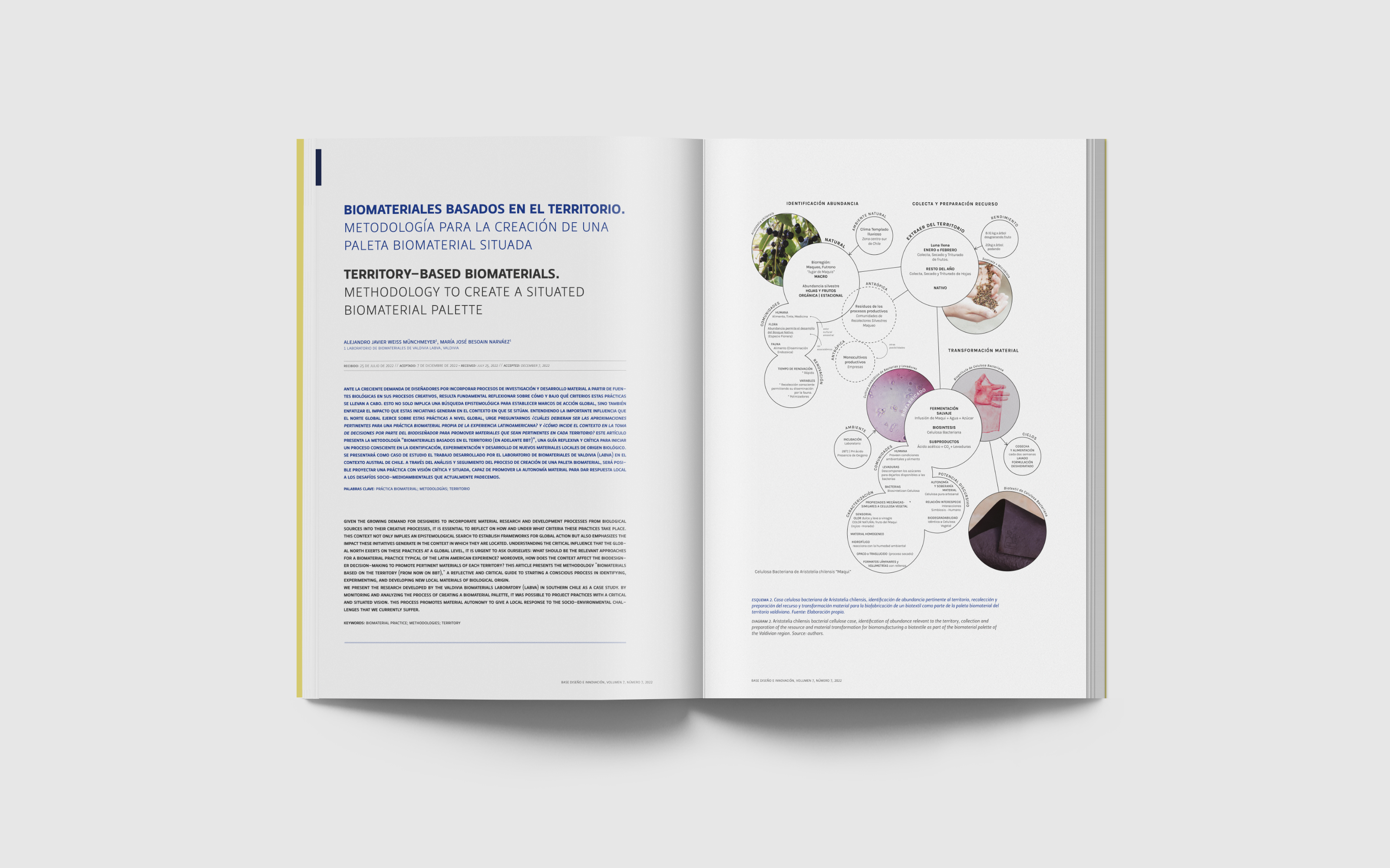Territory-based biomaterials Methodology to create a situated biomaterial palette
Main Article Content
Abstract
Given the growing demand for designers to incorporate material research and development processes from biological sources into their creative processes, it is essential to reflect on how and under what criteria these practices take place. This context not only implies an epistemological search to establish frameworks for global action but also emphasizes the impact these initiatives generate in the context in which they are located. Understanding the critical influence that the Global North exerts on these practices at a global level, it is urgent to ask ourselves: what should be the relevant approaches for a biomaterial practice typical of the Latin American experience? Moreover, how does the context affect the biodesigner decision-making to promote pertinent materials of each territory? This article presents the methodology "Biomaterials Based on the Territory (BBT)," a reflective and critical guide to starting a conscious process in identifying, experimenting, and developing new local materials of biological origin. We present the research developed by the Valdivia Biomaterials Laboratory (LABVA) in southern Chile as a case study. By monitoring and analyzing the process of creating a biomaterial palette, it was possible to project practices with a critical and situated vision. This process promotes material autonomy to give a local response to the socio-environmental challenges that we currently suffer.
Article Details
References
Berg, P. (2002). Bioregionalism: An Introduction. Planet Drum Foundation. https://www.planetdrum.org/bioregionalism_defined.htm
Berry, T. (1984) Bioregionalism: A Better Way to Understand Where You Live. The Tarrytown Letter, 41 (September 1984) 2-5. http://thomasberry.org/wp-content/uploads/Bioregionalism.pdf
Calafat, M. E. (1999). Materiales biológicos y biomateriales. http://www.rac.es/ficheros/doc/00330.pdf
Camere, S. & Karana, E. (2018). Fabricating materials from living organisms: An emerging design practice. Journal of Cleaner Production, 186, 570-584. https://doi.org/10.1016/j.jclepro.2018.03.081
Comisión Económica para América Latina y el Caribe (2017), Daño y pérdida de biodiversidad https://www.cepal.org/es/temas/biodiversidad/perdida-biodiversidad
Escobar, A. (2016). Autonomía y diseño. La realización de lo comunal. Universidad del Cauca.
Garmulewicz, A. (2018, Marzo 23) “Open Materials for a Circular Economy”. Seminario Biofabricando el Futuro, Universidad Católica, Santiago, Chile.
Karana, E., Barati, B., Rognoli, V., & Zeeuw Van Der Laan, A. (2015). Material driven design (MDD): A method to design for material experiences. International Journal of Design, 9(2), 35-54.
Karana, E., Blauwhoff, D., Hultink, E. -J., & Camere, S. (2018). When the material grows: A case study on designing (with) mycelium-based materials. International Journal of Design, 12(2), 119-136.
LABVA. [@somoslabva] (11 may 2020). LABVA pregunta: ¿Qué son los biomateriales? [Video]. Youtube. https://youtu.be/wU1-eZk7wqg
Lee, S., Congdon, A., Parker, G., & Borst, C. (2020). Understanding “bio” material innovations: a primer for the fashion industry. Biofabricate and Fashion for Good. https://fashionforgood.com/our_news/understanding-bio-material-innovations-a-primer-for-the-fashion-industry/
Manzini, E. (2015). Design, when everybody designs: an introduction to design for social
innovation. MIT Press.
Myers, W. (2012). Bio design: Nature, science, creativity. Museum of Modern Art. https://www.moma.org/momaorg/shared/pdfs/docs/publication_pdf/3167/BioDesign_PREVIEW.pdf?1349967238
Red Fungi (2018) Búsqueda y recolección de hongos degradadores de madera. https://redfungiblog.wordpress.com/protocolo-de-recoleccion/
Rodríguez, S., De Pablo, C., Besoain, M., (2021) “Bioderiva: ¿Cómo aproximarnos a organismos vivos para el desarrollo de nuevas materialidades?” Fondart de investigación en Diseño Convocatoria 2021 - Folio: 548393
Rognoli, V., Bianchini, M., Maffei, S., & Karana, E. (2015). DIY materials. Materials & Design, 86, 692-702. https://doi.org/10.1016/j.matdes.2015.07.020
Rognoli, V. y Ayala, C. (2018). Material activism. New hybrid scenarios between design and technology. Cuadernos del Centro de Estudios de Diseño y Comunicación, 1(70), 105-115. https://doi.org/10.18682/cdc.vi70.1143
Secretaría del Convenio sobre la Diversidad Biológica (2014), Perspectiva Mundial sobre la Diversidad Biológica 4. https://www.cbd.int/gbo/gbo4/publication/gbo4-es-hr.pdf


